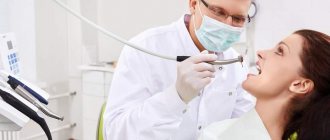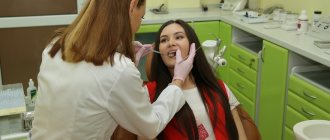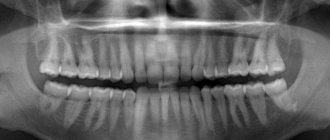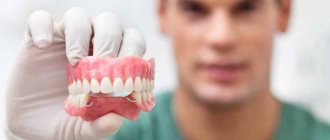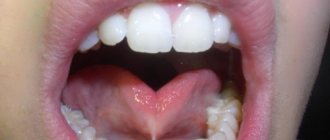4950
© Kzenon/Fotolia
For dental diseases, when conservative treatment does not bring positive results or is impossible, removal is resorted to. This procedure can only be performed by a dental surgeon.
His specialization includes not only tooth extraction, but also any surgical interventions on the maxillofacial apparatus.
What should this specialist know?
A highly qualified dental surgeon must be able to correctly make diagnoses, focusing not only on external signs, but also on diagnostic examination data. He must be able to quickly make important decisions regarding the extraction or preservation of a tooth, since the general health of the patient often depends on this.
For a surgeon, knowledge from other areas of dentistry is also important: therapy, orthodontics, implantology, since his work is often closely related to them.
A modern doctor should understand all the nuances and subtleties of modern surgical methods. Knowledge of psychology and the ability to find a common language with people are of primary importance, since surgical intervention is psychologically difficult for patients to perceive. This is especially important when working with children.
In addition, the dental surgeon must have therapeutic knowledge in order to promptly stop or prevent the development of postoperative complications.
Principles of remuneration in public and private clinics
The difference between private and public dentistry in remuneration can be quite significant. For example, in the capital, a dental therapist in a public clinic receives 50-60 thousand rubles , but in a private clinic, all other things being equal, he will receive 80-120 thousand rubles. In public medical institutions, a dentist’s salary consists of the official salary and various allowances. Among other things, such specialists receive additional payments for qualification categories, for a scientific degree (if any), etc.
In private clinics, salaries are calculated differently. At the same time, such institutions often compete with each other for good specialists, so everyone pays high salaries, and additionally attracts staff with good working conditions - a social package, modern equipment and optics, the presence of assistants, etc.
As a rule, if a dentist does not open his own office, but goes to work as an employee, then a plan for services is set for him, or more precisely, for their total amount. Depending on this, he receives the initially established percentage. At the same time, good clinics set a very realistic plan, taking into account the experience of previous months, and it is not difficult to implement it.
Salary for percentage
Pricing is usually determined by the clinic’s management. But in general, the price of relatively simple manipulations is determined by the cost of the materials used, to which a certain markup is added. However, in some areas of dentistry, the so-called technical cost of work is used - this is, for example, relevant for crowns and veneers, which are made not by the dentist himself, but by a dental technician. In this case, the percentage for calculating the salary of the dentist-therapist will be calculated a little differently. The markup itself can be almost any amount. In private clinics, it includes both payment of taxes and salaries of all staff, so it can be 200% or more.
Gray additional methods earnings
It also happens, of course, that not very conscientious doctors impose additional services where they could have done without it (mostly this concerns some aesthetic problems or professional oral hygiene services, but in general in reputable clinics this rarely happens).
Bonuses and awards
Most private clinics do not offer additional bonuses or bonuses. But some institutions practice training employees in courses and seminars at their own expense, and there are also those that include meals for employees in their benefits package.
Penalties
But there is a system of fines. Basically, they fine small sums for various violations of labor discipline - for example, for being late or for untimely filling out medical documentation. If the doctor makes any mistakes in treatment, then more stringent measures can be taken.
When working in a private clinic, you need to keep in mind that although the registration will be official everywhere, the management still wants to save on taxes. Therefore, many register as part-time doctors in order to minimize their contributions to the tax and pension fund.
Other professions: Profession veterinarian - prospects and salary
Tasks
© starush / Fotolia
The main objective of surgical treatment is the safe complete or partial removal of a tooth using properly selected anesthesia and aseptic preparations.
In addition, the surgeon’s specialization involves solving problems with abnormal development of the jaw, defects of the frenulum of the tongue or lip, and implantation.
Diagnostic methods
Before surgery, a general blood test and an HIV test are required. Additionally, allergy tests for local anesthetics or drugs for general anesthesia may be required. Another mandatory analysis is bacteriological culture. It is necessary for patient safety and protection against infection. In addition to testing, the patient will undergo a visual examination, x-ray, computed tomography or magnetic resonance imaging of the dentition and oral cavity.
Preparation
Before a planned operation, the patient must pass:
- general blood analysis;
- testing for HIV and other blood-borne infections;
- bacterial culture from the oral cavity.
In addition, the doctor will find out whether there is any intolerance to medications, in particular anesthetics and disinfectants.
You can undergo an examination using modern high-precision equipment and receive professional help from a dental surgeon at JSC Family Doctor. Below are the prices for services. You can make an appointment through the call center, mobile application or the patient’s personal account.
Consultation stages
Stages of consultation with a dental surgeon include:
- taking anamnesis;
- examination of the oral cavity, which uses palpation, percussion and auscultation;
- prescribing additional studies that allow you to establish an accurate diagnosis and choose treatment tactics.
What manipulations does it perform?
The surgeon's specialization involves performing a variety of manipulations, ranging from simple tooth extraction to plastic surgery of the maxillofacial apparatus. Each procedure has its own characteristics and requires special attention and full control from the specialist.
What manipulations does it perform?
The surgeon's specialization involves performing a variety of manipulations, ranging from simple tooth extraction to plastic surgery of the maxillofacial apparatus. Each procedure has its own characteristics and requires special attention and full control from the specialist.
Implantation
One of the most common methods for restoring an entire tooth. Implantation is carried out by implanting a titanium root into the jawbone, in place of the extracted tooth . If the clinic does not have a doctor with a specialization as an implantologist, the implantation is carried out by a surgeon.
In addition to the implant installation procedure, the surgeon may be required to perform additional manipulations aimed at restoring bone tissue in the area of implantation. Most often, it is necessary to first carry out a sinus lift - bone augmentation in the upper jaw in the area of the maxillary sinuses.
Also, a dental surgeon can work to remove the old implant or put an artificial crown on it.
Some of the nuances of this procedure are described in the following video:
Tooth extraction
Extraction is the most popular procedure performed by surgeons in dental clinics. To remove teeth, the doctor can use two methods:
- Simple . Mainly used when removing anterior units or premolars. The procedure involves extraction by breaking the periodontal ligaments and removing the tooth.
- Complex .
In demand on the last molars when they are incomplete or abnormal eruption. Removal is carried out after cutting the gum tissue to gain access to the roots. After this, the crown part is cut off, and the roots are separated using a dental bur and extractor. Then, each root is extracted one by one. In case of extensive periodontal lesions, or difficult removal, the gums are sutured.
Regardless of the method, extraction is carried out with preliminary local or general anesthesia.
Cystectomy
© diyanadimitrova / Fotolia
This procedure is a partial removal of the root of a tooth on multi-rooted teeth, and is used when a cyst is detected . Cystectomy allows you to remove a small cyst while preserving the main root part of the tooth.
The procedure begins with anesthesia, after which the doctor creates access to the tooth through the gum and periodontal tissue. In the opened bed, the dentist enucleates the cyst and removes it along with the tip of the affected root.
The root canal is cleaned and filled with a special material that promotes bone tissue restoration. Despite the fact that cystectomy is a radical technique, it allows you to save the tooth and the neurovascular bundle that feeds it.
What should the temperature be after tooth extraction and how to reduce it?
Let's talk here about the use of arsenic in dentistry.
Do you need to treat a wisdom tooth or remove it? https://www.vash-dentist.ru/hirurgiya/udalenie-zubov/nuzhno-li-mudrosti-obosnovanie-neobhodimosti.html we’ll tell you at the link.
Gumplasty
One of the common dental defects is incorrect placement of the gum contour. It can be congenital or acquired, due to periodontal inflammation. Such a defect leads to gum recession, gum disease, and the development of caries.
Gum grafting can help correct this problem . The surgeon, with simple manipulations, will increase the contour of the gums, lower them, or evenly distribute them over the entire periodontal part of the visible area.
This technique is especially actively used in cases of severe periodontal disease, when periodontal tissues are not able to recover on their own.
Gum grafting can be performed during flap surgery or as a stand-alone procedure with delayed surgery. If there is excessive formation of periodontal tissue, it is excised.
Insufficient volume or high position is compensated by dissection of the gums of the problem area or transplantation of a mucosal flap from another part of the oral cavity.
Restoring jaw proportions
© vzmaze/Fotolia
An abnormal change in the proportions of the jaw is primarily corrected by an orthodontist, but if conservative treatment is ineffective, the help of a surgeon is resorted to.
To restore the correct proportions of the maxillofacial apparatus, various types of osteoplastic surgeries are used in the horizontal and vertical directions:
- by lengthening the jaw arch . During surgery, the doctor cuts soft tissue to gain access to the problem area of the jaw bone. Then, this area is perforated, expansion plates are installed and a bone-replenishing substance is introduced, which will fill the resulting gap;
- by shortening the jaw arch . To do this, a small area is excised in the bone of the alveolar ridge and a tightening structure is fixed. During the treatment process, it requires regular activation.
The correction procedure can last from 1 to 3 months, during which the surgeon constantly monitors the treatment.
Flap operations
Patch-type operations are one of the most effective methods for restoring gums in case of periodontitis, thinning gums, and destruction of the jaw bone. The procedure eliminates enlarged gum pockets and overgrown periodontal tissue .
The operation involves removing tissue until the bone of the alveolar ridge is exposed. After this, the pathological epithelium and granulation are removed and the roots of the teeth are polished. If necessary, material is implanted to restore the bone.
A gum is formed from the remaining flap and fixed with sutures. A periodontal bandage is applied to the operated area. Despite the traumatic nature of the operation, healing occurs after 7–10 days.
Curettage
© casanowe / Fotolia
Inflammation of the gums is often provoked by plaque settling in periodontal pockets. To eliminate it, they resort to the help of a surgeon who removes subgingival deposits using special instruments - curettes.
They are able to penetrate under the gum to a depth of 5 mm and remove plaque, granulation tissue, and also deliver drugs with a soothing, anti-inflammatory and regenerating effect to the bottom of the pocket. In case of extensive exposure, a periodontal bandage is applied at the end of the procedure.
This procedure is presented schematically in the following video:
Bone grafting
Insufficiency of bone tissue in the area of implantation often requires the intervention of a dental surgeon, who restores the required volume using special materials.
They can be a synthetic bone-forming substance, material obtained from animal bone, or a small fragment of the patient’s own bone. The grafting procedure involves detachment of the mucous membrane and perforation of the bone, into which a restorative substance or fragment is injected.
Who is a dental surgeon?
A dentist who specializes in surgical methods for treating problems of the oral cavity and the entire facial-maxillary apparatus is called a dental surgeon. In addition to surgical treatment, this specialist also prepares the oral cavity for dental implantation (together with an orthopedist), and also deals with cosmetic correction of defects of the facial-maxillary apparatus.
What do these doctors do?
Dental surgeons treat teeth and gums. Surgical interventions allow the doctor to remove teeth, as well as make incisions for inflammatory processes and any operations in the maxillofacial area. In addition, the scope of activity of a dental surgeon includes:
- treatment of congenital and acquired pathologies;
- elimination of defects of the face, oral cavity, jaw;
- removal of benign and malignant tumors.
The doctor deals with diseases such as:
- perimaxillary abscess;
- temporomandibular arthritis;
- dislocations of joints and teeth;
- gingivitis;
- dental hyperesthesia and enamel hypoplasia;
- dental defects;
- infectious diseases of the teeth, gums, and entire oral cavity;
- caries;
- cysts;
- leukoplakia;
- periodontitis and periodontal disease;
- osteomyelitis of the jaws;
- fractures of teeth, jaws;
- pulpitis, stomatitis;
- fluxes and so on.
What does a dental surgeon treat?
Treatment of dental diseases often requires an integrated approach, so the use of surgical methods is one of the stages of sequential treatment measures.
A dental surgeon is a specialized specialist whose areas of activity include:
- removal of teeth or part of a tooth;
- treatment of inflammatory processes in the gums, jaw and face;
- elimination of jaw and facial defects (congenital and acquired);
- removal of neoplasms of the maxillofacial area.
In addition, the dental surgeon, together with the orthopedist, prepares the oral cavity for dental implantation and carries out cosmetic correction of the maxillofacial and oral area (vestibuloplasty, gingivoplasty, correction of the alveolar process, frenuloplasty, etc.).
A pediatric dental surgeon treats dental diseases of the maxillofacial area in children.
In what cases should I contact
Most often, a dental surgeon is associated with tooth extraction. Such surgical intervention is actually performed by this specialist. But the scope of a surgeon’s activity is much broader. The dentist makes incisions for advanced inflammatory processes, removes pathological formations, that is, performs any operations in the maxillofacial area.
Both congenital and acquired diseases can be treated through surgery. It can be:
- inflammatory gum diseases (gingivitis, stomatitis, periodontitis);
- enamel diseases (caries, hypoplasia);
- abscess near the jaw space;
- fractures of the jaw or teeth;
- jaw dislocations;
- defects in bite and dentition;
- fluxes;
- osteomyelitis of the jaw;
- tooth root cysts.
Any infectious disease of the oral cavity, if not sought for help in a timely manner, may require surgical intervention.
Surveys
X-rays are always taken before surgery. In most cases, the photograph is taken by the dental surgeon himself. In some cases, the doctor may refer the patient for orthopantomography or dental computed tomography.
Features of working with children
Working with children requires from the surgeon not only high professionalism, but also psychological preparation, as well as perseverance. It is a rare child who comes to see the dentist without fear.
Regardless of the upcoming manipulations, all children experience increased anxiety at the sight of dental equipment and many of them react violently with reluctance to listen to the doctor. To avoid this, the surgeon must be able to find an approach to every child of any age .
The process of establishing anesthesia is considered in a special way. The situation is greatly facilitated by topical anesthesia, used before the main anesthetic injection.
Children's age limits the volume of the drug administered and the time for the doctor's manipulations, so his actions must be quick and clear.
Reviews
- No. 1. Becoming a dentist requires a certain amount of persistence and determination. It took me a total of about 8 years to study, and I didn’t even count how many times I attended various seminars and conferences after receiving my diploma (well, there were already courses twice). I didn’t immediately understand what direction I wanted to work in, and only after the internship I came to the conclusion that I would be a pediatric dentist. Working with such patients is not easy, but there are more positive emotions. After the appointment, I always give my patients some kind of souvenir - soap bubbles or balls with the symbols of our clinic, and on my own behalf - certificates for bravery, I simply print them out on a printer. I work in a private clinic, the salary is 80-90 thousand rubles per month. Our team is good, overall I’m happy with everything.
- No. 2. I myself work as a dental surgeon, and my wife is a dental therapist. When we had the opportunity, we opened our own office. It wasn’t easy, and it wasn’t even a matter of finding clients; we literally lured many away when we left our previous place of work. It’s just that organizing an office is an expensive pleasure, considering all the standards. We try not to raise the markup too much in order to retain customers - the competition is still quite strong, and we set aside part of the money for upgrading equipment, so my monthly salary is 77-80 thousand rubles, my wife gets about the same (75 on average ).
Cosmetic surgeries
© Francesco83 / Fotolia
In addition to operations performed for therapeutic purposes, the surgeon performs interventions for cosmetic restoration of the maxillofacial apparatus.
Gingivoplasty
This technique is aimed at eliminating defects in periodontal tissue associated with its uneven position. Gingivoplasty is necessary for high, uneven or low gum lines.
For correction, periodontal tissue from the problem area is used, separated into flaps, or a flap is transferred from the palate. The periodontal tissue is given the required shape using surgical sutures, which are removed after 10 days.
Vestibuloplasty
It is a technique designed to expand the vestibule of the oral cavity by moving facial muscles deeper into it. The procedure is carried out by cutting the mucous tissue that regulates the tension of the gums.
After weakening the muscles of the vestibule, the likelihood of developing periodontal diseases decreases, and speech therapy problems are eliminated.
The vestibuloplasty procedure is presented in the following video:
We will tell you what to do if your gums hurt for a long time after tooth extraction.
We talk here about complications after removal and treatment.
We will discuss the resection of the apex of the tooth root at the link https://www.vash-dentist.ru/hirurgiya/rezektsiya/verhushki-kornya-zuba-zachem-nuzhna-operatsiya-i-kak-ona-provoditsya.html.
Frenuloplasty
The main indication for frenuloplasty is shortening of the frenulum of the tongue or lips , exposing the neck of the teeth, or the formation of a speech therapy defect. The incision is made under local anesthesia, using a scalpel to excise the frenulum in the transverse direction.
Elimination of gum recession
When the volume of the gums decreases (recession), accompanied by exposure of the roots of the teeth, flap surgery is resorted to. A section of mucous membrane taken from the palate or another area of the oral cavity is applied to the gum, after which the tissue is secured with sutures.
After a week, the mucous membrane takes root and the sutures are removed.
Indications for surgical treatment
If pain or other signs of a pathological process appear, the patient initially turns to a dentist-therapist. If conservative treatment fails, the patient is referred for consultation to a dental surgeon. Most often, the need for such treatment arises in the following cases:
- advanced carious process of wisdom teeth;
- the need to remove baby teeth for normal growth of permanent molars or incisors;
- rapidly progressing disease of the oral cavity with the formation of pus;
- third degree of periodontitis with mobility of incisors and molars;
- impossibility of restoring a molar or incisor damaged by caries;
- the presence of molars or incisors on the jaw fracture line;
- the need for implantation of prostheses.
The complexity of surgical treatment depends on the diagnosis and the degree of neglect of the disease. The position of a dental surgeon involves both simple and complex interventions. With a simple tooth extraction, the operation takes no more than 10 minutes and is performed in a dental office. Surgeries for complex diseases are performed in a hospital setting under general anesthesia. After such an intervention, the patient should remain under medical supervision for several more days.
Interaction with other specialties
© Robert Kneschke/Fotolia
The specialty of a dental surgeon involves close interaction with doctors from all areas of dentistry. The surgeon can remove teeth only after the therapist confirms the impossibility of saving them .
Extraction cannot be carried out without the testimony of an orthodontist, who monitors the correct development of the bite and dentition. The work of an orthopedist also cannot do without the participation of a surgeon, since in order to install dentures, it is necessary to remove all roots and bad teeth.
If you find an error, please select a piece of text and press Ctrl+Enter.
Tags: implantation, tooth removal
Did you like the article? stay tuned
Previous article
Orthopedic dentist: what does this specialist do and what does he treat?
Next article
Dental prosthetics without turning: types, advantages, prices
How is tooth extraction performed?
Patients may delay removal for a long time because they are afraid that it will hurt. But modern dentistry allows this procedure to be performed absolutely painlessly.
The surgeon at the SDent clinic individually selects the dose and type of anesthetic. This allows you to achieve complete pain relief in each specific case. Only after the patient feels numbness in the desired area of the jaw, the surgeon begins the operation: the doctor pushes back the gum and carefully removes the tooth from the bone. Atraumatic removal promotes rapid tissue healing. In addition, the postoperative period will be as comfortable as possible for the patient.
After removal, the surgeon gives recommendations and, if necessary, prescribes medications and painkillers.
Prospects for the profession
An aspiring practitioner begins as a dental intern in one of the private or public clinics. Then, gaining experience and knowledge, he begins to treat patients independently and takes control of other interns. Over time, the dentist becomes deputy chief physician. The peak of the career is the position of chief physician. In such a role, a specialist has a large area of responsibility, which requires strong skills and knowledge.
Another direction of development is scientific activity. Starting with graduate school, you can get your first scientific degree. Developing further, you can grow to the degree of Doctor of Science. The peak of a career in this case is opening your own educational institution or heading the department of dentistry in one of the existing ones.
One way or another, the path of a promising doctor begins with the successful completion of one of the programs of the Department of Dentistry at a specialized higher educational institution. However, obtaining a diploma is only the beginning of the educational process. To succeed in the profession, you need to regularly improve your qualifications and keep your finger on the pulse of the development of this medical industry.





